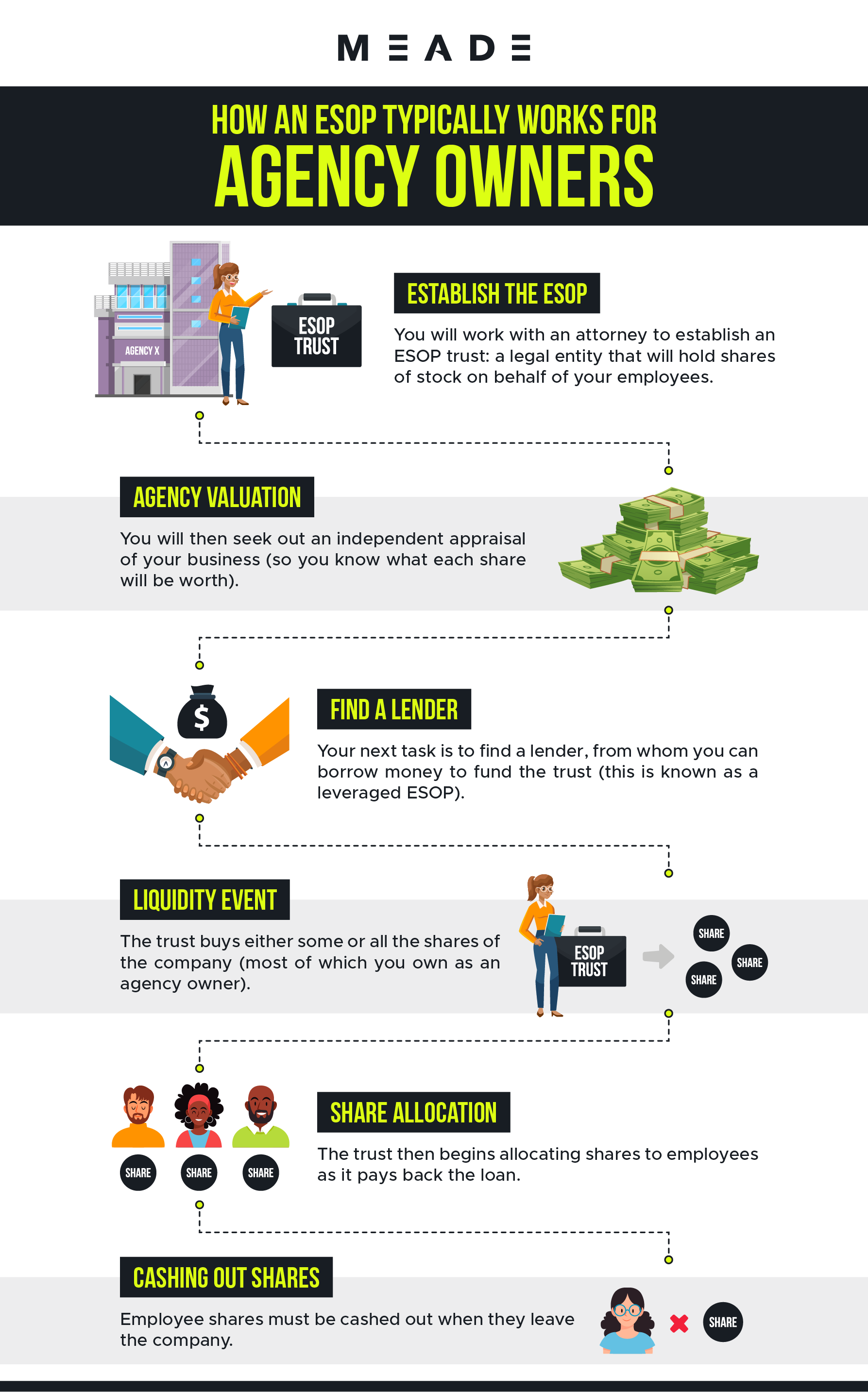Employee Stock Ownership Plan: Pros and Cons
Agency leaders, good news: there are many options available for those looking to transition out of their business. The potential avenues include selling a partial or 100% ownership stake to an outside buyer, a family member, an employee stock ownership plan (ESOP), or simply closing your doors. No matter your choice, all of us will eventually transition out of our businesses one day. My goal is to help you think about exiting on your terms.
What is an ESOP?
An ESOP—short for “employee stock ownership plan”—is a tax-exempt retirement plan that gives workers an ownership stake in the business where they are employed. According to the National Center for Employee Ownership (https://www.nceo.org/), about two-thirds of ESOPs are created to provide a market for a departing owner’s shares.
The ESOP creation process is relatively simple. First, a trust is established that borrows money from a bank to buy company shares (most of which are held by the agency owner). Then, the trust distributes shares to employees' retirement accounts according to a defined vesting schedule (a schedule that dictates when employees can acquire full ownership of contributions made to their retirement plan). Here’s an example. Let’s say you have an employee who is 100% vested; this simply means that the full balance of the retirement account belongs to them. Employees cannot sell shares until they leave the company or retire. But—and this is an important but—agencies are required to purchase back the vested shares at fair market value.
Pros of Selling to an ESOP
Liquidity Event: Creates a buyer for your ownership shares.
Talent Retention: Provides a sense of belonging where employees have an incentive to stay engaged.
Open-Book Management: Develops a culture of transparency where business decisions and financial information is shared with the entire staff.
Retirement Planning: Employees do not have to use their own money to acquire equity.
Cons of Selling to an ESOP
High Set-Up Costs: Establishing an ESOP generally costs north of $40K (this includes an appraisal, accounting, and legal fees). Additionally, you can plan on maintenance expenses of roughly $20K annually.
Stock-Buy Backs: Your agency is required to purchase employee shares when they leave your firm.
Open-Book Management: This is a departure for many agency owners who are used to only sharing financial information and important business decisions with senior leadership.
Repaying Buyout Debt: Paying back buyout debt on the loan can present cash flow problems for your agency.
Should you pursue an ESOP?
To answer this question, I’d like to channel author Simon Sinek and Start with Why. Specifically, the question we must answer is this: “Why pursue an ESOP with all the retirement options available for both you and your employees?”
From the perspective of an owner, your “why” is to put some cash in your pocket as you transition out of the business. An ESOP creates a legal entity to buy your shares.
From the perspective of your employees, their “why” is to have a certain level of income in retirement as a reward for being long-time employees.
ESOPs lack diversity as a retirement vehicle because they are fully invested in the stock of your agency. Additionally, agency owners might be seduced by the notion of giving their employees equity in the business. The truth is that—considering this industry’s low barrier to entry—your employees would have their own agency if they wanted to be owners. In reality, they don't want to be owners; or better yet, they don't want to be agency owners anymore. Many folks on your team have tried their hand at running an agency, and determined that being the #2 or #3 suits them a lot better. If you want to thank your employees above and beyond salary, then profit sharing is a much better reward than the risks of ownership.
Ultimately, my advice is to not pursue an ESOP. The risks do not outweigh the rewards. If you are interested in discussing your transition options, then check out our Agency Coaching service where we help agency owners begin having discussions around transition options.

